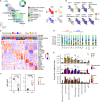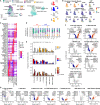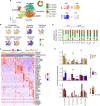The single cell transcriptional landscape of esophageal adenocarcinoma and its modulation by neoadjuvant chemotherapy
- PMID: 36253784
- PMCID: PMC9575245
- DOI: 10.1186/s12943-022-01666-x
The single cell transcriptional landscape of esophageal adenocarcinoma and its modulation by neoadjuvant chemotherapy
Abstract
Immune checkpoint blockade has recently proven effective in subsets of patients with esophageal adenocarcinoma (EAC) but little is known regarding the EAC immune microenvironment. We determined the single cell transcriptional profile of EAC in 8 patients who were treatment-naive (n = 4) or had received neoadjuvant chemotherapy (n = 4). Analysis of 52,387 cells revealed 10 major cell subsets of tumor, immune and stromal cells. Prior to chemotherapy tumors were heavy infiltrated by T regulatory cells and exhausted effector T cells whilst plasmacytoid dendritic cells were markedly expanded. Two dominant cancer-associated fibroblast populations were also observed whilst endothelial populations were suppressed. Pathological remission following chemotherapy associated with broad reversal of immune abnormalities together with fibroblast transition and an increase in endothelial cells whilst a chemoresistant epithelial stem cell population correlated with poor response. These findings reveal features that underlie and limit the response to current immunotherapy and identify a range of novel opportunities for targeted therapy.
Keywords: Cancer-associated fibroblast; Esophageal adenocarcinoma; Plasmacytoid dendritic cell; Regulatory T cell; scRNA-Seq.
© 2022. The Author(s).
Conflict of interest statement
The authors declare no competing interests.
Figures








References
-
- Al-Batran S-E, Homann N, Pauligk C, Goetze TO, Meiler J, Kasper S, et al. Perioperative chemotherapy with fluorouracil plus leucovorin, oxaliplatin, and docetaxel versus fluorouracil or capecitabine plus cisplatin and epirubicin for locally advanced, resectable gastric or gastro-oesophageal junction adenocarcinoma (FLOT4): a randomised, phase 2/3 trial. Lancet. 2019;393:1948–1957. doi: 10.1016/S0140-6736(18)32557-1. - DOI - PubMed
Publication types
MeSH terms
Substances
Supplementary concepts
Grants and funding
LinkOut - more resources
Full Text Sources
Medical
Molecular Biology Databases

